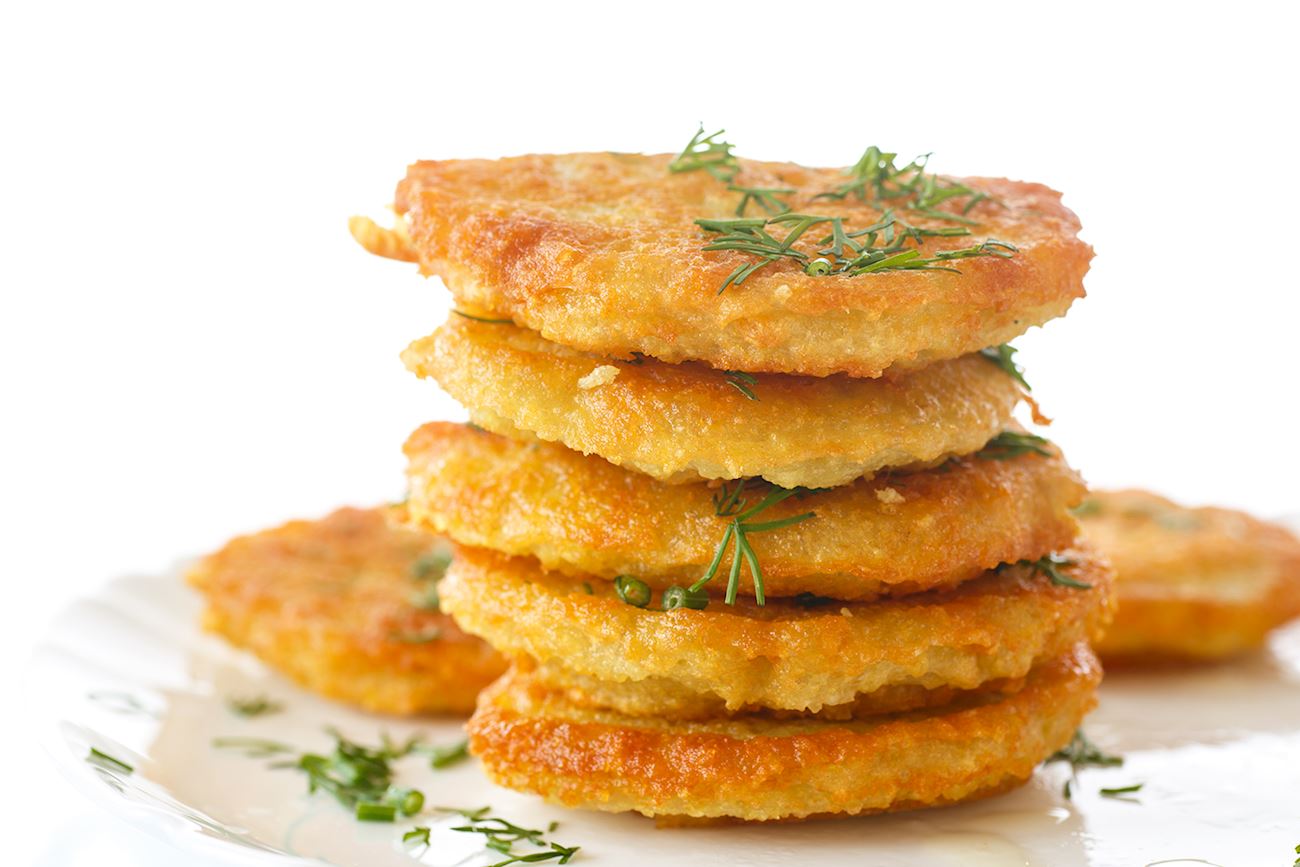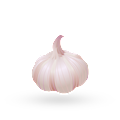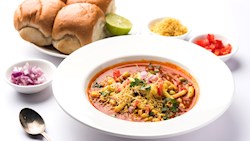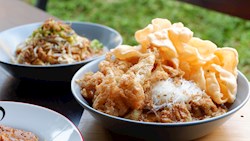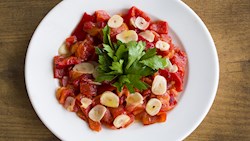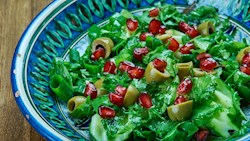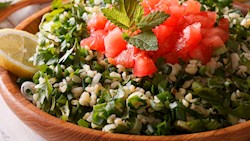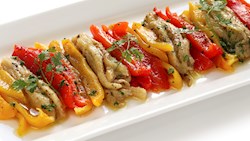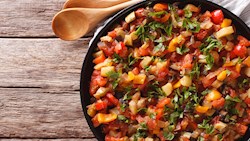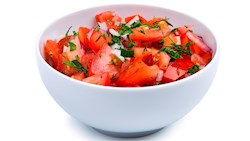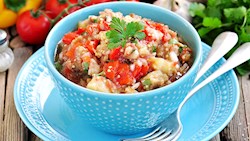MAIN INGREDIENTS
Often touted as the original version of falafels, taameya is an Egyptian variety of the Middle Eastern fritter that calls for fava beans instead of chickpeas. While the exact origin of falafel is debatable, most scholars and food historians agree that taameya has its roots in the Egyptian cuisine.
The fava bean mixture is typically flavored with leeks, onions, fresh coriander, parsley, and cumin, and the fritters are usually coated with sesame seeds before frying. Taameya are known for having a lighter, fluffier, and moister texture than other falafel varieties thanks to the use of fava beans.
VARIATIONS OF Taameya
MOST ICONIC Taameya
View moreMAIN INGREDIENTS
Maakouda are traditional potato fritters that are popular throughout the Maghreb, especially in Morocco, Algeria, and Tunisia. The fritters are usually prepared plain, but they can also be stuffed with meat, tuna, or cheese, although not that often.
They're made with potatoes, parsley, garlic, flour, salt, and pepper. The potatoes are boiled, mashed, and mixed with other ingredients into small disks which are then deep-fried in hot oil until golden brown. Maakouda is traditionally served as an appetizer, a side dish, or an ingredient in a long sandwich roll that's usually sold as street food and served with harissa, coriander, and lemon juice.
MAIN INGREDIENTS
Mahjouba is a traditional flatbread that is one of the most popular street food items in the country. These thick and flaky crepe-like flatbreads are made with semolina, then filled with a combination of tomatoes and caramelized onions. Mahjouba is often paired with harissa sauce on the side, but the condiment is completely optional.
MAIN INGREDIENTS
Diri ak pwa, also called diri kole ak pwa, is the national dish of Haiti, consisting of rice and beans. The dish became a common, everyday staple during the period of slavery, when rice and beans were two of the few ingredients that were fed to the slaves by their owners.
It can be made with a variety of beans, but pinto, red kidney beans, and black beans are the most common options. Diri ak pwa is exceptionally nutritious as rice is rich in starch and contains iron, vitamin B, and protein, while the beans also contain iron and a greater amount of protein than rice.
Guacamole is a world-famous buttery delicacy dating back all the way to the Aztec empire of the 1500s. It’s a healthy blend of ripe, mashed avocados, onions, chiles, optional tomatillos and selected seasonings such as sea salt and coriander.
The star of this incredibly simple dish is the avocado, high in unsaturated fat, potassium, vitamins, minerals and protein, its name stemming from the Aztec ahuacatl, meaning testicle or testicle tree, which is why it was believed that it was an aphrodisiac by the Aztecs.
Guacamole is sometimes prepared in the molcajete, a traditional Mexican mortar and pestle where onions, chiles, and salt are ground to a paste and added to the coarsely mashed avocados. Of course, guacamole is only as good as the avocados it is prepared with, and among the best are the nutty and creamy Hass and smooth Fuerte avocados.
MOST ICONIC Guacamole
View moreMAIN INGREDIENTS
This internationally popular, beige-colored spread is traditionally made with mashed chickpeas, tahini sesame paste, lemon juice, and garlic. People across the world love hummus for its tangy flavor and the fact that it is filled with nutrients.
When served, it is typically dressed with a drizzle of olive oil, and is then used as a dip for vegetables or a flavorful filling for flatbreads such as pita. Even today, not much is known about its origins, although the earliest mention of hummus dates back to 13th-century Egypt.
VARIATIONS OF Hummus
MOST ICONIC Hummus
View moreMAIN INGREDIENTS
Yemista or gemista is a Greek dish traditionally consisting of vegetables such as tomatoes and green peppers that are stuffed with rice and vegetables' inner parts. The stuffed vegetables are then baked in the oven. The name of the dish means stuffed in Greek language, and it's a typical summer dish.
It is mainly considered a vegan dish, although there are some that prepare it with ground meat in the stuffing. It is recommended to prepare the dish when the vegetables are at the peak of the season and to serve it garnished with a spoon of Greek strained yogurt and accompanied by feta cheese.
MOST ICONIC Yemista
View moreMAIN INGREDIENTS
Atsuage is a traditional dish consisting of deep-fried tofu. The slices of tofu are wrapped in kitchen paper and weighed down with a small weight so the water drains well. They are then deep-fried until golden brown, puffy, and slightly crunchy on the exterior.
On the inside, the tofu should remain silky soft. This dish is often prepared as an inexpensive source of protein and it’s eaten as it is with soy sauce, grated ginger, or various vegetables.
MAIN INGREDIENTS
Mayak is a popular variety of South Korean rice rolls (gimbap). These mini versions of the standard roll consist of rice, toasted seaweed, and fillings that traditionally include carrots, pickled radish, and spinach. Unlike the traditional gimbap, mayak is never sliced.
The rolls are sprinkled with sesame seeds, while soy sauce and mustard dip is usually served on the side. It is believed that mayak rolls originated at Gwang-jang market in Seoul. Their captivating name translates as narcotic, not because of the presence of an illegal substance, but because once you try these miniature rolls, you will always be hungry for more.
MAIN INGREDIENTS
Misir wat or tsebhi birse nis a traditional and Eritrean dish and a type of wat (Ethiopian and Eritrean stew). In order to prepare it, onions are sautéed in niter kibbeh clarified butter, followed by garlic, ginger, tomato paste, berbere spices, stock, and lentils.
The stew is slowly simmered until the lentils become soft, and the dish is then usually enriched with a bit more berbere spices and niter kibbeh near the end of cooking. Misir wat is served warm and it's usually accompanied by injera flatbread on the side, which is used to scoop up the lentils.
TasteAtlas food rankings are based on the ratings of the TasteAtlas audience, with a series of mechanisms that recognize real users and that ignore bot, nationalist or local patriotic ratings, and give additional value to the ratings of users that the system recognizes as knowledgeable. For the “Top 100 Vegan Dishes in the World” list until February 13, 2025, 22,914 ratings were recorded, of which 12,182 were recognized by the system as legitimate. TasteAtlas Rankings should not be seen as the final global conclusion about food. Their purpose is to promote excellent local foods, instill pride in traditional dishes, and arouse curiosity about dishes you haven’t tried.
